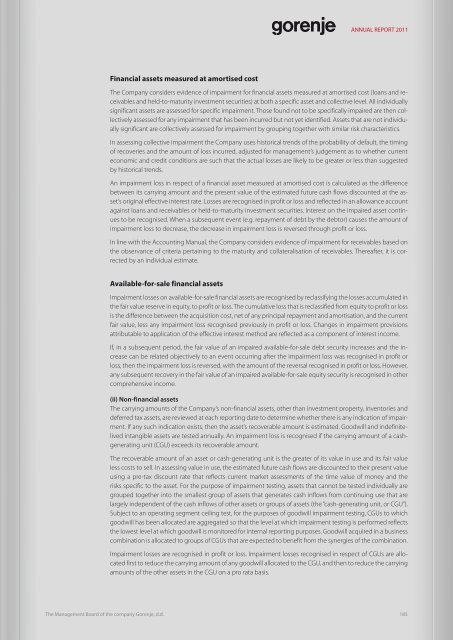2.8 MEUR - Gorenje - Gorenje Group
2.8 MEUR - Gorenje - Gorenje Group
2.8 MEUR - Gorenje - Gorenje Group
Create successful ePaper yourself
Turn your PDF publications into a flip-book with our unique Google optimized e-Paper software.
Financial assets measured at amortised cost<br />
ANNUAL REPORT 2011<br />
The Company considers evidence of impairment for financial assets measured at amortised cost (loans and receivables<br />
and held-to-maturity investment securities) at both a specific asset and collective level. All individually<br />
significant assets are assessed for specific impairment. Those found not to be specifically impaired are then collectively<br />
assessed for any impairment that has been incurred but not yet identified. Assets that are not individually<br />
significant are collectively assessed for impairment by grouping together with similar risk characteristics.<br />
In assessing collective impairment the Company uses historical trends of the probability of default, the timing<br />
of recoveries and the amount of loss incurred, adjusted for management’s judgement as to whether current<br />
economic and credit conditions are such that the actual losses are likely to be greater or less than suggested<br />
by historical trends.<br />
An impairment loss in respect of a financial asset measured at amortised cost is calculated as the difference<br />
between its carrying amount and the present value of the estimated future cash flows discounted at the asset’s<br />
original effective interest rate. Losses are recognised in profit or loss and reflected in an allowance account<br />
against loans and receivables or held-to-maturity investment securities. Interest on the impaired asset continues<br />
to be recognised. When a subsequent event (e.g. repayment of debt by the debtor) causes the amount of<br />
impairment loss to decrease, the decrease in impairment loss is reversed through profit or loss.<br />
In line with the Accounting Manual, the Company considers evidence of impairment for receivables based on<br />
the observance of criteria pertaining to the maturity and collateralisation of receivables. Thereafter, it is corrected<br />
by an individual estimate.<br />
Available-for-sale financial assets<br />
Impairment losses on available-for-sale financial assets are recognised by reclassifying the losses accumulated in<br />
the fair value reserve in equity, to profit or loss. The cumulative loss that is reclassified from equity to profit or loss<br />
is the difference between the acquisition cost, net of any principal repayment and amortisation, and the current<br />
fair value, less any impairment loss recognised previously in profit or loss. Changes in impairment provisions<br />
attributable to application of the effective interest method are reflected as a component of interest income.<br />
If, in a subsequent period, the fair value of an impaired available-for-sale debt security increases and the increase<br />
can be related objectively to an event occurring after the impairment loss was recognised in profit or<br />
loss, then the impairment loss is reversed, with the amount of the reversal recognised in profit or loss. However,<br />
any subsequent recovery in the fair value of an impaired available-for-sale equity security is recognised in other<br />
comprehensive income.<br />
(ii) Non-financial assets<br />
The carrying amounts of the Company’s non-financial assets, other than investment property, inventories and<br />
deferred tax assets, are reviewed at each reporting date to determine whether there is any indication of impairment.<br />
If any such indication exists, then the asset’s recoverable amount is estimated. Goodwill and indefinitelived<br />
intangible assets are tested annually. An impairment loss is recognised if the carrying amount of a cash-<br />
The Management Board of the company <strong>Gorenje</strong>, d.d.<br />
generating unit (CGU) exceeds its recoverable amount.<br />
The recoverable amount of an asset or cash-generating unit is the greater of its value in use and its fair value<br />
less costs to sell. In assessing value in use, the estimated future cash flows are discounted to their present value<br />
using a pre-tax discount rate that reflects current market assessments of the time value of money and the<br />
risks specific to the asset. For the purpose of impairment testing, assets that cannot be tested individually are<br />
grouped together into the smallest group of assets that generates cash inflows from continuing use that are<br />
largely independent of the cash inflows of other assets or groups of assets (the “cash-generating unit, or CGU”).<br />
Subject to an operating segment ceiling test, for the purposes of goodwill impairment testing, CGUs to which<br />
goodwill has been allocated are aggregated so that the level at which impairment testing is performed reflects<br />
the lowest level at which goodwill is monitored for internal reporting purposes. Goodwill acquired in a business<br />
combination is allocated to groups of CGUs that are expected to benefit from the synergies of the combination.<br />
Impairment losses are recognised in profit or loss. Impairment losses recognised in respect of CGUs are allocated<br />
first to reduce the carrying amount of any goodwill allocated to the CGU, and then to reduce the carrying<br />
amounts of the other assets in the CGU on a pro rata basis.<br />
The Management Board of the company <strong>Gorenje</strong>, d.d. 185


